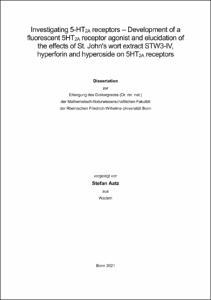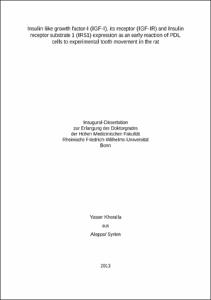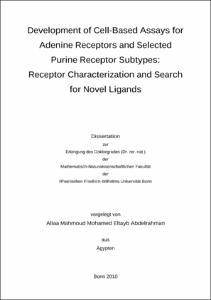Aatz, Stefan: Investigating 5-HT2A receptors - Development of a fluorescent 5HT2A receptor agonist and elucidation of the effects of St. John's wort extract STW3-IV, hyperforin and hyperoside on 5HT2A receptors. - Bonn, 2021. - Dissertation, Rheinische Friedrich-Wilhelms-Universität Bonn.
Online-Ausgabe in bonndoc: https://nbn-resolving.org/urn:nbn:de:hbz:5-63231
Online-Ausgabe in bonndoc: https://nbn-resolving.org/urn:nbn:de:hbz:5-63231
@phdthesis{handle:20.500.11811/9309,
urn: https://nbn-resolving.org/urn:nbn:de:hbz:5-63231,
author = {{Stefan Aatz}},
title = {Investigating 5-HT2A receptors - Development of a fluorescent 5HT2A receptor agonist and elucidation of the effects of St. John's wort extract STW3-IV, hyperforin and hyperoside on 5HT2A receptors},
school = {Rheinische Friedrich-Wilhelms-Universität Bonn},
year = 2021,
month = sep,
note = {Investigating 5-HT2A receptors - Development of a fluorescent 5HT2A receptor agonist and elucidation of the effects of St. John's wort extract STW3-IV, hyperforin and hyperoside on 5HT2A receptors Serotonin 2A (5-5HT2A) receptors are involved in the treatment and development of a variety of diseases. It was proven in various pre-clinical and clinical settings that influencing their activity is important in the treatment of depressive disorders. St. John's wort extracts have been used to treat depressive disorders for decades, but their influence on the 5-5HT2A receptor is still not fully understood. To get a deeper understanding of the influences St. John's wort extracts exhibit on 5-5HT2A receptors, a fluorescently labeled 5-5HT2A receptor agonist was synthesized in the first part of this work. Using fluorescence correlation spectroscopy (FCS) measurements, the ligand was characterized for its binding affinity and selectivity to 5-5HT2A receptors. Additionally, two distinct diffusive states of slow and fast diffusing receptor-ligand complexes were determined. The lateral mobility of 5-5HT2A receptor-ligand complexes was further investigated in single-particle tracking (SPT) experiments. Furthermore, the agonistic activity of the constructed ligand was determined using the calcium-dependent, fluorescent reporter protein B-GECO1 stably transfected into HEK293 cells together with the 5-5HT2A receptor.
In the second part of this work, the newly constructed fluorescent ligand was used to investigate the influence of the St. John's wort extract STW3-VI® on the 5-5HT2A receptor. Receptor binding studies using FCS on SH-SY5Y cells showed a dose-dependent increase in 5-5HT2A receptor binding after preincubation with STW3-VI®, whereas two of its active ingredients hyperforin and hyperoside showed no significant effects. Interestingly, the receptor-ligand complexes were redistributed in a dose-dependent manner to their faster diffusing state for STW3-VI®, hyperforin and hyperoside. However, this effect was most pronounced for STW3-VI®. The receptor-ligand complexes with increased lateral mobility are presumably less able to induce their downstream signaling, due to reduced interactions with their respective G protein. The postulated inhibition of 5-5HT2A receptor signaling after preincubation with STW3-VI® was further investigated by measuring receptor density, internalization after stimulation and signaling activity. Therefore, two luminescence-based HEK293 reporter cell lines were created and stably transfected with the 5-5HT2A receptor. Receptor density and internalization were investigated using the Nano-Glo® HiBiT Extracellular Detection System. Again, STW3-VI® dose-dependently inhibited 5-5HT2A receptor activity by reducing the receptor density and internalization after stimulation with the agonist (±)-TCB-2. Hyperforin and hyperoside displayed neither significant effects on receptor density nor internalization after agonistic stimulation. Lastly, the signaling activity after preincubation with STW3-VI®, hyperforin and hyperoside was investigated with the luminescent, calcium-dependent reporter protein aequorin. Intracellular calcium levels after agonistic stimulation with the 5-5HT2A receptor agonist (±)-TCB-2 were significantly reduced after preincubation with STW3-VI®. This effect again could not be explained by either hyperforin or hyperoside, since both displayed no significant influences on 5-5HT2A receptor induced calcium signaling.
These findings indicate a correlation between receptor activity and mobility for 5-5HT2A receptors. STW3-VI® clearly demonstrated its inhibitory effect on 5-5HT2A receptors in the cellular models used within this work. By using different fluorescence- und luminescence-based approaches, deeper insights into the interactions of St. John's wort extract STW3-VI® and 5-5HT2A receptors were made possible. This contributes to the better understanding of 5-5HT2A receptors themselves, their involvement in the treatment of depressive disorders and the therapeutic effects observed after the administration of St. John's wort extracts.},
url = {https://hdl.handle.net/20.500.11811/9309}
}
urn: https://nbn-resolving.org/urn:nbn:de:hbz:5-63231,
author = {{Stefan Aatz}},
title = {Investigating 5-HT2A receptors - Development of a fluorescent 5HT2A receptor agonist and elucidation of the effects of St. John's wort extract STW3-IV, hyperforin and hyperoside on 5HT2A receptors},
school = {Rheinische Friedrich-Wilhelms-Universität Bonn},
year = 2021,
month = sep,
note = {Investigating 5-HT2A receptors - Development of a fluorescent 5HT2A receptor agonist and elucidation of the effects of St. John's wort extract STW3-IV, hyperforin and hyperoside on 5HT2A receptors Serotonin 2A (5-5HT2A) receptors are involved in the treatment and development of a variety of diseases. It was proven in various pre-clinical and clinical settings that influencing their activity is important in the treatment of depressive disorders. St. John's wort extracts have been used to treat depressive disorders for decades, but their influence on the 5-5HT2A receptor is still not fully understood. To get a deeper understanding of the influences St. John's wort extracts exhibit on 5-5HT2A receptors, a fluorescently labeled 5-5HT2A receptor agonist was synthesized in the first part of this work. Using fluorescence correlation spectroscopy (FCS) measurements, the ligand was characterized for its binding affinity and selectivity to 5-5HT2A receptors. Additionally, two distinct diffusive states of slow and fast diffusing receptor-ligand complexes were determined. The lateral mobility of 5-5HT2A receptor-ligand complexes was further investigated in single-particle tracking (SPT) experiments. Furthermore, the agonistic activity of the constructed ligand was determined using the calcium-dependent, fluorescent reporter protein B-GECO1 stably transfected into HEK293 cells together with the 5-5HT2A receptor.
In the second part of this work, the newly constructed fluorescent ligand was used to investigate the influence of the St. John's wort extract STW3-VI® on the 5-5HT2A receptor. Receptor binding studies using FCS on SH-SY5Y cells showed a dose-dependent increase in 5-5HT2A receptor binding after preincubation with STW3-VI®, whereas two of its active ingredients hyperforin and hyperoside showed no significant effects. Interestingly, the receptor-ligand complexes were redistributed in a dose-dependent manner to their faster diffusing state for STW3-VI®, hyperforin and hyperoside. However, this effect was most pronounced for STW3-VI®. The receptor-ligand complexes with increased lateral mobility are presumably less able to induce their downstream signaling, due to reduced interactions with their respective G protein. The postulated inhibition of 5-5HT2A receptor signaling after preincubation with STW3-VI® was further investigated by measuring receptor density, internalization after stimulation and signaling activity. Therefore, two luminescence-based HEK293 reporter cell lines were created and stably transfected with the 5-5HT2A receptor. Receptor density and internalization were investigated using the Nano-Glo® HiBiT Extracellular Detection System. Again, STW3-VI® dose-dependently inhibited 5-5HT2A receptor activity by reducing the receptor density and internalization after stimulation with the agonist (±)-TCB-2. Hyperforin and hyperoside displayed neither significant effects on receptor density nor internalization after agonistic stimulation. Lastly, the signaling activity after preincubation with STW3-VI®, hyperforin and hyperoside was investigated with the luminescent, calcium-dependent reporter protein aequorin. Intracellular calcium levels after agonistic stimulation with the 5-5HT2A receptor agonist (±)-TCB-2 were significantly reduced after preincubation with STW3-VI®. This effect again could not be explained by either hyperforin or hyperoside, since both displayed no significant influences on 5-5HT2A receptor induced calcium signaling.
These findings indicate a correlation between receptor activity and mobility for 5-5HT2A receptors. STW3-VI® clearly demonstrated its inhibitory effect on 5-5HT2A receptors in the cellular models used within this work. By using different fluorescence- und luminescence-based approaches, deeper insights into the interactions of St. John's wort extract STW3-VI® and 5-5HT2A receptors were made possible. This contributes to the better understanding of 5-5HT2A receptors themselves, their involvement in the treatment of depressive disorders and the therapeutic effects observed after the administration of St. John's wort extracts.},
url = {https://hdl.handle.net/20.500.11811/9309}
}









